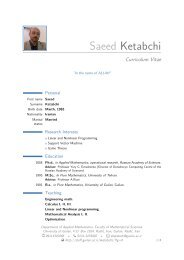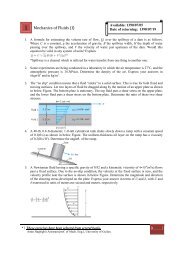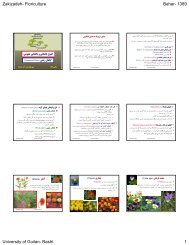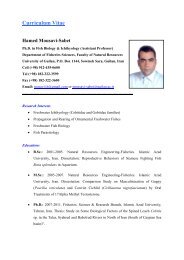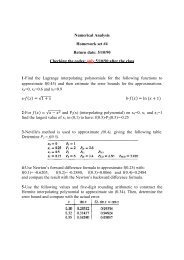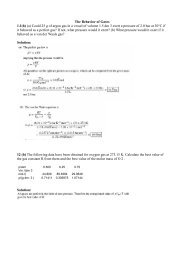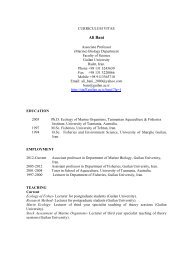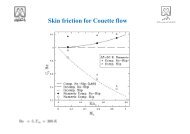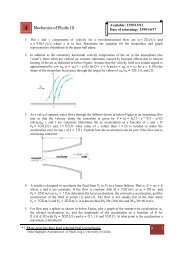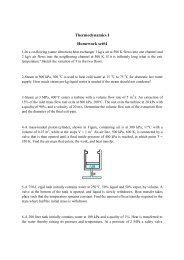- Page 4:
Medical Tourism inDeveloping Countr
- Page 7:
This page intentionally left blank
- Page 11 and 12:
List of AcronymsAIDS Acquired Immun
- Page 13 and 14:
This page intentionally left blank
- Page 15 and 16:
2 ● Medical Tourism in Developing
- Page 17 and 18:
4 ● Medical Tourism in Developing
- Page 19 and 20:
6 ● Medical Tourism in Developing
- Page 21 and 22:
8 ● Medical Tourism in Developing
- Page 23 and 24:
10 ● Medical Tourism in Developin
- Page 25 and 26:
12 ● Medical Tourism in Developin
- Page 27 and 28:
14 ● Medical Tourism in Developin
- Page 29 and 30:
Table 1.1 Economic indicators and t
- Page 31 and 32:
18 ● Medical Tourism in Developin
- Page 33 and 34:
This page intentionally left blank
- Page 35 and 36:
22 ● Medical Tourism in Developin
- Page 37 and 38:
24 ● Medical Tourism in Developin
- Page 40 and 41:
Plastic Surgery is Not Peanuts ●
- Page 43 and 44:
30 ● Medical Tourism in Developin
- Page 45 and 46:
32 ● Medical Tourism in Developin
- Page 47 and 48:
34 ● Medical Tourism in Developin
- Page 49 and 50:
36 ● Medical Tourism in Developin
- Page 51 and 52:
38 ● Medical Tourism in Developin
- Page 53 and 54:
This page intentionally left blank
- Page 55 and 56: 42 ● Medical Tourism in Developin
- Page 57 and 58: 44 ● Medical Tourism in Developin
- Page 59 and 60: 46 ● Medical Tourism in Developin
- Page 61 and 62: 48 ● Medical Tourism in Developin
- Page 63 and 64: 50 ● Medical Tourism in Developin
- Page 65 and 66: 52 ● Medical Tourism in Developin
- Page 67 and 68: 54 ● Medical Tourism in Developin
- Page 69 and 70: 56 ● Medical Tourism in Developin
- Page 71 and 72: 58 ● Medical Tourism in Developin
- Page 73 and 74: 60 ● Medical Tourism in Developin
- Page 75 and 76: 62 ● Medical Tourism in Developin
- Page 77 and 78: 64 ● Medical Tourism in Developin
- Page 79 and 80: 66 ● Medical Tourism in Developin
- Page 81 and 82: 68 ● Medical Tourism in Developin
- Page 83 and 84: 70 ● Medical Tourism in Developin
- Page 85 and 86: 72 ● Medical Tourism in Developin
- Page 87 and 88: 74 ● Medical Tourism in Developin
- Page 89 and 90: 76 ● Medical Tourism in Developin
- Page 91 and 92: 78 ● Medical Tourism in Developin
- Page 93 and 94: 80 ● Medical Tourism in Developin
- Page 95 and 96: 82 ● Medical Tourism in Developin
- Page 97 and 98: 84 ● Medical Tourism in Developin
- Page 99 and 100: 86 ● Medical Tourism in Developin
- Page 101 and 102: 88 ● Medical Tourism in Developin
- Page 103 and 104: 90 ● Medical Tourism in Developin
- Page 105: 92 ● Medical Tourism in Developin
- Page 109 and 110: 96 ● Medical Tourism in Developin
- Page 111 and 112: 98 ● Medical Tourism in Developin
- Page 113 and 114: 100 ● Medical Tourism in Developi
- Page 115 and 116: 102 ● Medical Tourism in Developi
- Page 117 and 118: 104 ● Medical Tourism in Developi
- Page 119 and 120: 106 ● Medical Tourism in Developi
- Page 121 and 122: 108 ● Medical Tourism in Developi
- Page 123 and 124: 110 ● Medical Tourism in Developi
- Page 125 and 126: 112 ● Medical Tourism in Developi
- Page 127 and 128: Table 5.4 Indicators of physical in
- Page 129 and 130: 116 ● Medical Tourism in Developi
- Page 131 and 132: 118 ● Medical Tourism in Developi
- Page 133 and 134: 120 ● Medical Tourism in Developi
- Page 135 and 136: 122 ● Medical Tourism in Developi
- Page 137 and 138: 124 ● Medical Tourism in Developi
- Page 139 and 140: 126 ● Medical Tourism in Developi
- Page 141 and 142: 128 ● Medical Tourism in Developi
- Page 143 and 144: 130 ● Medical Tourism in Developi
- Page 145 and 146: 132 ● Medical Tourism in Developi
- Page 147 and 148: 134 ● Medical Tourism in Developi
- Page 149 and 150: 136 ● Medical Tourism in Developi
- Page 151 and 152: This page intentionally left blank
- Page 153 and 154: 140 ● Medical Tourism in Developi
- Page 155 and 156: 142 ● Medical Tourism in Developi
- Page 157 and 158:
144 ● Medical Tourism in Developi
- Page 159 and 160:
146 ● Medical Tourism in Developi
- Page 161 and 162:
148 ● Medical Tourism in Developi
- Page 163 and 164:
150 ● Medical Tourism in Developi
- Page 165 and 166:
152 ● Medical Tourism in Developi
- Page 167 and 168:
154 ● Medical Tourism in Developi
- Page 169 and 170:
156 ● Medical Tourism in Developi
- Page 171 and 172:
158 ● Medical Tourism in Developi
- Page 173 and 174:
160 ● Medical Tourism in Developi
- Page 175 and 176:
162 ● Medical Tourism in Developi
- Page 177 and 178:
164 ● Medical Tourism in Developi
- Page 179 and 180:
166 ● Medical Tourism in Developi
- Page 181 and 182:
168 ● Medical Tourism in Developi
- Page 183 and 184:
170 ● Medical Tourism in Developi
- Page 185 and 186:
172 ● Medical Tourism in Developi
- Page 187 and 188:
174 ● Medical Tourism in Developi
- Page 189 and 190:
176 ● Medical Tourism in Developi
- Page 191 and 192:
178 ● Medical Tourism in Developi
- Page 193 and 194:
180 ● Medical Tourism in Developi
- Page 195 and 196:
182 ● Medical Tourism in Developi
- Page 197 and 198:
184 ● Medical Tourism in Developi
- Page 199 and 200:
This page intentionally left blank
- Page 201 and 202:
188 ● NotesTreatment Abroad Could
- Page 203 and 204:
190 ● Notes60. Emerging markets i
- Page 205 and 206:
192 ● Notes21. Woodward et al.,
- Page 207 and 208:
194 ● Notes57. Economist, July 31
- Page 209 and 210:
196 ● Notes25. New York Times, De
- Page 211 and 212:
198 ● Notes73. Rupa Chanda, “Tr
- Page 213 and 214:
200 ● Notes16. Peter Schofield,
- Page 215 and 216:
202 ● Notes56. Thomas Friedman, T
- Page 217 and 218:
204 ● Notes99. Chanda, “Trade i
- Page 219 and 220:
206 ● Notes21. Marvin Cetron, Fre
- Page 221 and 222:
208 ● Notes71. Chanda, “Trade i
- Page 223 and 224:
210 ● Notes116. Cited in Rashmi B
- Page 225 and 226:
212 ● Notes2. Simonetta Zarrilli,
- Page 227 and 228:
214 ● Notes30. Joint Commission I
- Page 229 and 230:
216 ● Notes65. Mattoo and Rathind
- Page 231 and 232:
218 ● Notes102. It is a problem i
- Page 233 and 234:
220 ● Notes29. Larry Solomon, “
- Page 235 and 236:
This page intentionally left blank
- Page 237 and 238:
224 ● Selected BibliographyBower,
- Page 239 and 240:
226 ● Selected BibliographyJohans
- Page 241 and 242:
228 ● Selected BibliographyRoffe,
- Page 243 and 244:
This page intentionally left blank
- Page 245 and 246:
232 ● Indexbrain drain/gain 105-9
- Page 247 and 248:
234 ● Indexdestination countriesa
- Page 249 and 250:
236 ● Indexhealth careon airplane
- Page 251 and 252:
238 ● IndexJJohanson, Misty 44, 9
- Page 253 and 254:
240 ● Indexmedical tourism (conti
- Page 255 and 256:
242 ● Indexpublic health (continu
- Page 257 and 258:
244 ● Indextourism sectormarket s






